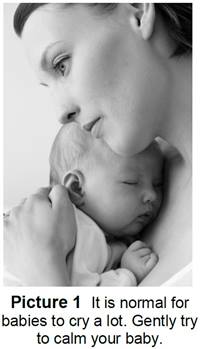Abusive Head Trauma

Abusive head trauma (AHT), formerly called Shaken Baby Syndrome, is a form of child abuse. It happens when an infant’s head is moved rapidly, then suddenly stops. This is done with abrupt, intense motion, such as violent shaking or forceful throwing of a baby. This can injure a baby’s brain.
- AHT may happen when caregivers, like parents, babysitters, or other family members, get upset or angry when a baby will not stop crying.
- AHT is the #1 cause of child abuse deaths in the United States. If it does not cause death, the child may have life-long problems like:
- Seizures
- Behavior disorders
- Cerebral palsy
- Impaired physical and mental development
- Children of any race, financial status, or background can be victims. It is important for caregivers to know that excessive crying is normal in infants and young children.
Signs and Symptoms of SBS
These are signs and symptoms to look for if you think your baby is an AHT victim.
Early Signs
- Waking them up is hard
- Crying that cannot be consoled
- Not eating or nursing
- Looking pale or blue (color change)
- Throwing up (vomiting)
- Bruising anywhere on them if they're less than 6 months old. Unexplained bruising when they're older.
Late Signs
- No heartbeat
- Child will not respond or wake up
- Breathing problems
- Seizures and shaking (convulsions)
Comforting a Crying Baby
Babies may cry a lot. Caregivers need to know that this is normal. Babies may cry because they're sick or hungry, or there may not be a cause. Try these things to help comfort your
crying baby:

- Nurse or feed
- Gently rock
- Burp
- Check for illness or teething
- Gently rub their back or head (Picture 1)
- Take them for a ride in a stroller or car
- Check for tight clothing or wet diaper
Preventing AHT
Remember, it is okay to walk away if you find yourself getting frustrated or angry with your baby or child. It will not hurt your baby to keep crying.
- Gently and safely place your baby on their back in a crib or swing. All railings or safety belts must be secure before walking away. Check on them every 5 to 10 minutes. After you have safely placed your child in a crib or swing, get help by:
- Calling a friend, relative, or parent hotline for help and support.
- Asking a friend or family member to watch your child while you take a break.
- Doing something to take your mind off the crying.
- Calling the doctor if you are worried about your child’s crying.
More Information
These centers and websites can offer more information and support on Shaken Baby Syndrome:
- National Parent Helpline - 1 (855) 4A-PARENT (427-2736), www.nationalparenthelpline.org
- National Center on Shaken Baby Syndrome, www.dontshake.org
- The Center for Family Safety and Healing - (614) 722-8200
- Choices for Victims of Domestic Violence, Franklin County - (614) 224-4663
- Franklin County Children Services Child Abuse Hotline - (614) 229-7000
HH-I-366 • ©2014, revised 2022 • Nationwide Children’s Hospital
